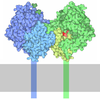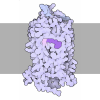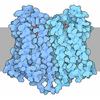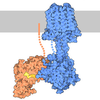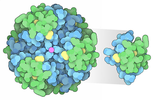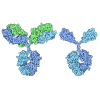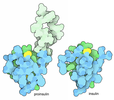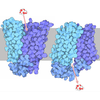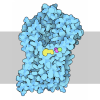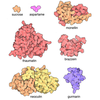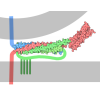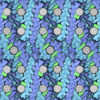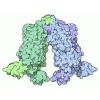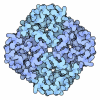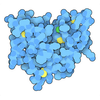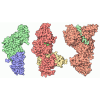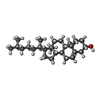[English] 日本語
 Yorodumi
Yorodumi- PDB-7xbw: Cryo-EM structure of the human chemokine receptor CX3CR1 in compl... -
+ Open data
Open data
- Basic information
Basic information
| Entry | Database: PDB / ID: 7xbw | ||||||||||||
|---|---|---|---|---|---|---|---|---|---|---|---|---|---|
| Title | Cryo-EM structure of the human chemokine receptor CX3CR1 in complex with Gi1 | ||||||||||||
 Components Components |
| ||||||||||||
 Keywords Keywords | SIGNALING PROTEIN / G protein-coupled receptor / chemokine receptor / CX3CR1 | ||||||||||||
| Function / homology |  Function and homology information Function and homology informationC-X3-C chemokine receptor activity / dendritic tree / multiple spine synapse organization, single dendrite / negative regulation of microglial cell mediated cytotoxicity / macropinosome membrane / C-X3-C chemokine binding / regulation of microglial cell migration / CX3C chemokine receptor binding / microglial cell activation involved in immune response / autocrine signaling ...C-X3-C chemokine receptor activity / dendritic tree / multiple spine synapse organization, single dendrite / negative regulation of microglial cell mediated cytotoxicity / macropinosome membrane / C-X3-C chemokine binding / regulation of microglial cell migration / CX3C chemokine receptor binding / microglial cell activation involved in immune response / autocrine signaling / host-mediated modulation of intestinal microbiota composition / synapse pruning / central nervous system maturation / synapse maturation / negative regulation of hippocampal neuron apoptotic process / antifungal innate immune response / chemokine receptor activity / leukocyte tethering or rolling / regulation of tumor necrosis factor production / C-C chemokine receptor activity / C-C chemokine binding / positive regulation of monocyte chemotaxis / leukocyte chemotaxis / G protein-coupled peptide receptor activity / regulation of nitric oxide biosynthetic process / positive regulation of neurogenesis / Chemokine receptors bind chemokines / negative regulation of interleukin-1 beta production / neuronal cell body membrane / positive regulation of neuroblast proliferation / RSV-host interactions / Respiratory syncytial virus (RSV) attachment and entry / negative regulation of apoptotic signaling pathway / social behavior / regulation of neurogenesis / cellular defense response / adenylate cyclase inhibitor activity / positive regulation of protein localization to cell cortex / Adenylate cyclase inhibitory pathway / T cell migration / D2 dopamine receptor binding / response to prostaglandin E / adenylate cyclase regulator activity / G protein-coupled serotonin receptor binding / adenylate cyclase-inhibiting serotonin receptor signaling pathway / cellular response to forskolin / regulation of mitotic spindle organization / negative regulation of angiogenesis / response to ischemia / cell chemotaxis / Regulation of insulin secretion / positive regulation of cholesterol biosynthetic process / calcium-mediated signaling / negative regulation of insulin secretion / G protein-coupled receptor binding / G protein-coupled receptor activity / response to peptide hormone / adenylate cyclase-inhibiting G protein-coupled receptor signaling pathway / brain development / regulation of synaptic plasticity / modulation of chemical synaptic transmission / adenylate cyclase-modulating G protein-coupled receptor signaling pathway / response to wounding / G-protein beta/gamma-subunit complex binding / centriolar satellite / Olfactory Signaling Pathway / Activation of the phototransduction cascade / G beta:gamma signalling through PLC beta / Presynaptic function of Kainate receptors / Thromboxane signalling through TP receptor / G protein-coupled acetylcholine receptor signaling pathway / G-protein activation / Activation of G protein gated Potassium channels / Inhibition of voltage gated Ca2+ channels via Gbeta/gamma subunits / Prostacyclin signalling through prostacyclin receptor / G beta:gamma signalling through CDC42 / chemotaxis / Glucagon signaling in metabolic regulation / G beta:gamma signalling through BTK / Synthesis, secretion, and inactivation of Glucagon-like Peptide-1 (GLP-1) / ADP signalling through P2Y purinoceptor 12 / photoreceptor disc membrane / Sensory perception of sweet, bitter, and umami (glutamate) taste / Glucagon-type ligand receptors / Adrenaline,noradrenaline inhibits insulin secretion / Vasopressin regulates renal water homeostasis via Aquaporins / GDP binding / Glucagon-like Peptide-1 (GLP1) regulates insulin secretion / G alpha (z) signalling events / cellular response to catecholamine stimulus / ADP signalling through P2Y purinoceptor 1 / ADORA2B mediated anti-inflammatory cytokines production / G beta:gamma signalling through PI3Kgamma / Cooperation of PDCL (PhLP1) and TRiC/CCT in G-protein beta folding / adenylate cyclase-activating dopamine receptor signaling pathway / GPER1 signaling / Inactivation, recovery and regulation of the phototransduction cascade / cellular response to prostaglandin E stimulus / G-protein beta-subunit binding / heterotrimeric G-protein complex Similarity search - Function | ||||||||||||
| Biological species |  Homo sapiens (human) Homo sapiens (human) | ||||||||||||
| Method | ELECTRON MICROSCOPY / single particle reconstruction / cryo EM / Resolution: 2.8 Å | ||||||||||||
 Authors Authors | Lu, M. / Zhao, W. / Han, S. / Zhu, Y. / Wu, B. / Zhao, Q. | ||||||||||||
| Funding support |  China, 3items China, 3items
| ||||||||||||
 Citation Citation |  Journal: Sci Adv / Year: 2022 Journal: Sci Adv / Year: 2022Title: Activation of the human chemokine receptor CX3CR1 regulated by cholesterol. Authors: Minmin Lu / Wenli Zhao / Shuo Han / Xiaowen Lin / Tingyu Xu / Qiuxiang Tan / Mu Wang / Cuiying Yi / Xiaojing Chu / Weibo Yang / Ya Zhu / Beili Wu / Qiang Zhao /  Abstract: As the only member of the CX3C chemokine receptor subfamily, CX3CR1 binds to its sole endogenous ligand CX3CL1, which shows notable potential as a therapeutic target in atherosclerosis, cancer, and ...As the only member of the CX3C chemokine receptor subfamily, CX3CR1 binds to its sole endogenous ligand CX3CL1, which shows notable potential as a therapeutic target in atherosclerosis, cancer, and neuropathy. However, the drug development of CX3CR1 is hampered partially by the lack of structural information. Here, we present two cryo-electron microscopy structures of CX3CR1-G complexes in ligand-free and CX3CL1-bound states at 2.8- and 3.4-Å resolution, respectively. Together with functional data, the structures reveal the key factors that govern the recognition of CX3CL1 by both CX3CR1 and US28. A much smaller conformational change of helix VI upon activation than previously solved class A GPCR-G complex structures is observed in CX3CR1, which may correlate with three cholesterol molecules that play essential roles in conformation stabilization and signaling transduction. Thus, our data deepen the understanding of cholesterol modulation in GPCR (G protein-coupled receptor) signaling and provide insights into the diversity of G protein coupling. | ||||||||||||
| History |
|
- Structure visualization
Structure visualization
| Structure viewer | Molecule:  Molmil Molmil Jmol/JSmol Jmol/JSmol |
|---|
- Downloads & links
Downloads & links
- Download
Download
| PDBx/mmCIF format |  7xbw.cif.gz 7xbw.cif.gz | 174.2 KB | Display |  PDBx/mmCIF format PDBx/mmCIF format |
|---|---|---|---|---|
| PDB format |  pdb7xbw.ent.gz pdb7xbw.ent.gz | 126.1 KB | Display |  PDB format PDB format |
| PDBx/mmJSON format |  7xbw.json.gz 7xbw.json.gz | Tree view |  PDBx/mmJSON format PDBx/mmJSON format | |
| Others |  Other downloads Other downloads |
-Validation report
| Summary document |  7xbw_validation.pdf.gz 7xbw_validation.pdf.gz | 1.3 MB | Display |  wwPDB validaton report wwPDB validaton report |
|---|---|---|---|---|
| Full document |  7xbw_full_validation.pdf.gz 7xbw_full_validation.pdf.gz | 1.3 MB | Display | |
| Data in XML |  7xbw_validation.xml.gz 7xbw_validation.xml.gz | 35.6 KB | Display | |
| Data in CIF |  7xbw_validation.cif.gz 7xbw_validation.cif.gz | 51.5 KB | Display | |
| Arichive directory |  https://data.pdbj.org/pub/pdb/validation_reports/xb/7xbw https://data.pdbj.org/pub/pdb/validation_reports/xb/7xbw ftp://data.pdbj.org/pub/pdb/validation_reports/xb/7xbw ftp://data.pdbj.org/pub/pdb/validation_reports/xb/7xbw | HTTPS FTP |
-Related structure data
| Related structure data | 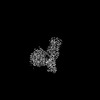 33107MC  7xbxC M: map data used to model this data C: citing same article ( |
|---|---|
| Similar structure data | Similarity search - Function & homology  F&H Search F&H Search |
- Links
Links
- Assembly
Assembly
| Deposited unit | 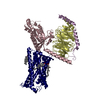
|
|---|---|
| 1 |
|
- Components
Components
| #1: Protein | Mass: 40447.141 Da / Num. of mol.: 1 / Mutation: S47C,G202T,G203A,E245A,A326S Source method: isolated from a genetically manipulated source Source: (gene. exp.)  Homo sapiens (human) / Gene: GNAI1 / Production host: Homo sapiens (human) / Gene: GNAI1 / Production host:  | ||||
|---|---|---|---|---|---|
| #2: Protein | Mass: 38245.805 Da / Num. of mol.: 1 Source method: isolated from a genetically manipulated source Source: (gene. exp.)  Homo sapiens (human) / Gene: GNB1 / Production host: Homo sapiens (human) / Gene: GNB1 / Production host:  | ||||
| #3: Protein | Mass: 7861.143 Da / Num. of mol.: 1 Source method: isolated from a genetically manipulated source Source: (gene. exp.)  Homo sapiens (human) / Gene: GNG2 / Production host: Homo sapiens (human) / Gene: GNG2 / Production host:  | ||||
| #4: Protein | Mass: 41072.680 Da / Num. of mol.: 1 / Mutation: I120L, C221S, M250V Source method: isolated from a genetically manipulated source Source: (gene. exp.)  Homo sapiens (human) / Gene: CX3CR1, CMKBRL1, GPR13 / Production host: Homo sapiens (human) / Gene: CX3CR1, CMKBRL1, GPR13 / Production host:  | ||||
| #5: Chemical | | Has ligand of interest | N | Has protein modification | Y | |
-Experimental details
-Experiment
| Experiment | Method: ELECTRON MICROSCOPY |
|---|---|
| EM experiment | Aggregation state: PARTICLE / 3D reconstruction method: single particle reconstruction |
- Sample preparation
Sample preparation
| Component | Name: Chemokine receptor CX3CR1 in complex with Gi1 / Type: COMPLEX / Entity ID: #1-#4 / Source: RECOMBINANT |
|---|---|
| Source (natural) | Organism:  Homo sapiens (human) Homo sapiens (human) |
| Source (recombinant) | Organism:  |
| Buffer solution | pH: 7.5 |
| Specimen | Embedding applied: NO / Shadowing applied: NO / Staining applied: NO / Vitrification applied: YES |
| Vitrification | Cryogen name: ETHANE |
- Electron microscopy imaging
Electron microscopy imaging
| Experimental equipment |  Model: Titan Krios / Image courtesy: FEI Company |
|---|---|
| Microscopy | Model: FEI TITAN KRIOS |
| Electron gun | Electron source:  FIELD EMISSION GUN / Accelerating voltage: 300 kV / Illumination mode: SPOT SCAN FIELD EMISSION GUN / Accelerating voltage: 300 kV / Illumination mode: SPOT SCAN |
| Electron lens | Mode: BRIGHT FIELD / Nominal defocus max: 1500 nm / Nominal defocus min: 800 nm |
| Image recording | Electron dose: 2.1875 e/Å2 / Film or detector model: GATAN K3 BIOQUANTUM (6k x 4k) |
- Processing
Processing
| Software |
| ||||||||||||||||||||||||
|---|---|---|---|---|---|---|---|---|---|---|---|---|---|---|---|---|---|---|---|---|---|---|---|---|---|
| CTF correction | Type: NONE | ||||||||||||||||||||||||
| 3D reconstruction | Resolution: 2.8 Å / Resolution method: FSC 0.143 CUT-OFF / Num. of particles: 702722 / Symmetry type: POINT | ||||||||||||||||||||||||
| Refinement | Cross valid method: NONE Stereochemistry target values: GeoStd + Monomer Library + CDL v1.2 | ||||||||||||||||||||||||
| Displacement parameters | Biso mean: 52.17 Å2 | ||||||||||||||||||||||||
| Refine LS restraints |
|
 Movie
Movie Controller
Controller



 PDBj
PDBj
